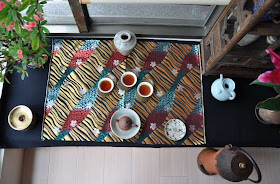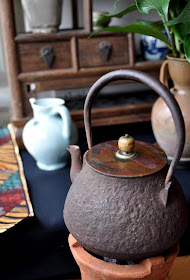I kept this Cha Xi as simple as possible. A big black fabric is my Cha Bu and lets each accessory stand out. Everything is clean and has a purpose.
In this time of New Year resolutions, we may wonder what new teas and tastes 2012 will bring us. My grandfather reminds me that, in life, every one of us can't receive more than what we give. So, to receive a lot, we should first learn to give. In tea, the same rule applies. High quality teas made with care and love yield more pleasure than mass produced leaves. And the more you learn and understand tea, the better you are likely to brew it. The study of tea and history is one that can yield great rewards.
On this day, for instance, I felt like drinking my
2011 spring Hung Shui Oolong from Shan Lin Shi and had started a charcoal fire in my brazier. Then I realized that I had very little of that tea left in my little porcelain jar. And a lot of it was crushed. (From the picture, you can see the spent leaves). This is typical of what happens when you arrive at the end of your tea pack. At first, I thought these few leaves are no worth brewing in this setting, but I quickly change my mind.
These remaining leaves and bits had spent several weeks in this porcelain jar. This allowed the Oolong to refine and mellow. The vivid fragrances were magnified and so tempting. Also, I remembered that Teaparker often repeated this saying by an ancient tea master: "Qi fen cha, san fen mo", meaning '70% leaf, 30% powder'. This is the right balance to brew Oolong Chaoshan style.
It may surprise us today that ancient experts would crush their leaves. Tea dust is what tea bags are made of! Brewing whole leaves helps reduce astringency and bitterness. So, why would a tea master crush his tea on purpose?
In Chao Shan, they also insisted on top tea quality. Wu Yi teas were exported to Europe, the USA and cost a lot of money. So, to reduce the cost of a brew, they used very small teapots. But Wu Yi cultivars have big and hard leaves that are not suitable to rolling like Taiwanese Oolongs. Their dry leaves take quite a lot of volume and would quickly fill the teapot. The taste would be too light for this kind of tea. So, to pack more tea inside and obtain a stronger taste, they found that adding 30% of crushed tea bits achieved the best results.
Broken tea leaves release their aromas faster than whole leaves. So, the key success factor for this method is to use high quality leaves that don't contain nasty astringency or lasting bitterness. This was the case for the Wu Yi teas brewed in Chao Shan and it is the case with my Oolong.
So, I used my smallest zhuni teapot to brew this Hung Shui Oolong. Even so, the open leaves barely filled a third of the teapot. I compensated this fact with a longer brewing time. (And I poured the hot water very slowly, since the broken leaves didn't need to be unfurled much.)
Hung Shui Oolong is quite different in character than Wu Yi Oolong. High mountain Hung Shui Oolong stands even further apart. The high elevation produces a tea with a lighter oxidation where the cooling, fresh feeling is more present. It doesn't require the same concentration level as Wu Yi Oolongs, I feel. With this method and these leaves, this brew already got a much stronger, thicker body. But it remained sweet, not bitter. And the Cha qi in the first brew felt more than powerful.
Of course, with so few leaves and many of them broken, the tea got exhausted faster. Still, even the third and last brew was very pleasant. The tea felt even better, because I had a very good conscience: I had treated this tea with respect and brewed even the last broken bit. And this very small amount of Oolong had given me 3 balanced and thick brews filled with refined aromas.
Tea is amazing! Sometimes, with the right understanding and tea, the less you have and the more can get out of it!





















































